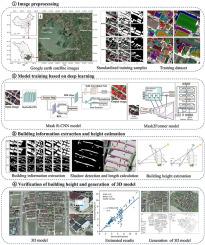从像素到三维模型:mask2former驱动的江南传统村落遥感影像自动重建
IF 7.4
2区 工程技术
Q1 CONSTRUCTION & BUILDING TECHNOLOGY
引用次数: 0
摘要
三维建模对建筑工程、可视化和设计具有重要意义,但在建筑遗产保护和乡村振兴中仍存在可扩展性、成本和人工劳动密集型等问题,难以大规模应用。为了解决这些问题,本研究提出了一种新的基于深度学习的方法,该方法首次将实例分割、Mask2Former和Mask R-CNN与遥感图像的阴影衍生高度估计相结合,实现了江南传统村庄的自动三维重建。使用深度学习算法Mask2Former和Mask R-CNN自动训练和预测建筑物和阴影的数据集。形态学后处理对提取的传统村落二值掩模轮廓进行正则化处理,通过计算阴影长度估计建筑高度。最后,通过比较两个村庄的无人机倾斜摄影的深度学习估计高度和测量高度进行验证。结果表明,Mask2Former具有更好的性能,准确率为88.95%,精密度为89.46%。所有建筑物的平均绝对误差、均方根误差和平均绝对百分比误差分别为0.53 m、0.92 m和9.59%,证实了该方法估算建筑物高度的可靠性。本研究提供了一种自动化、高效、低成本的农村建筑三维建模技术,解决了可扩展的传统村庄遗产数字化的关键需求。本文章由计算机程序翻译,如有差异,请以英文原文为准。

From pixels to 3D models: Mask2Former-driven automated reconstruction of Jiangnan traditional villages using remote sensing images
3D modeling is of great significance to building engineering, visualization and design, but it remains challenges of scalability, cost, and labor-intensive manual processes that are difficult to apply on a large scale in building heritage preservation and rural revitalization. To address these issues, this study proposes a novel deep learning-based approach, which for the first time combines instance segmentation, Mask2Former and Mask R-CNN, with shadow-derived height estimation from remote sensing images to achieve automated 3D reconstruction of Jiangnan traditional villages. Deep learning algorithms, Mask2Former and Mask R-CNN, were used to automatically train and predict the datasets of buildings and shadows. Morphological post-processing was then applied to regularize the extracted binary mask contours of traditional villages, and building heights were estimated through calculated shadow lengths. Finally, validation was conducted through comparisons between deep learning-estimated and measured heights from unmanned aerial vehicle tilt photography across two villages. Results demonstrate that, Mask2Former shows better performance, with accuracy of 88.95 % and precision of 89.46 %. The mean absolute error, root mean square error, and mean absolute percentage error are of all buildings are 0.53 m, 0.92 m, 9.59 %, respectively, confirming the reliability of the proposed approach in estimating building heights. This study provides an automated, efficient, and low-cost technique for 3D modeling in rural buildings, addressing the critical need for scalable traditional villages heritage digitization.
求助全文
通过发布文献求助,成功后即可免费获取论文全文。
去求助
来源期刊

Journal of building engineering
Engineering-Civil and Structural Engineering
CiteScore
10.00
自引率
12.50%
发文量
1901
审稿时长
35 days
期刊介绍:
The Journal of Building Engineering is an interdisciplinary journal that covers all aspects of science and technology concerned with the whole life cycle of the built environment; from the design phase through to construction, operation, performance, maintenance and its deterioration.
 求助内容:
求助内容: 应助结果提醒方式:
应助结果提醒方式:


